“If you have an apple and I have an apple and we exchange these apples then you and I will still each have one apple. But if you have an idea and I have an idea and we exchange these ideas, then each of us will have two ideas.”
-- George Bernard Shaw
Here you will find a brain dump of all that I know about human powered vehicles, with a particular focus on tilting recumbent trikes. I plan to write at least one article every two weeks, covering all the research I have done in this area. The empty headings below provide clues as to what's coming.
My hope is that these articles will help new home builders avoid making those really big mistakes, the ones that only seem obvious in hindsight. Rather than be prescriptive, I want to delve into some of the detail, so that if you choose to venture off into uncharted territory, you can still adapt some of the fundamental principals to your designs.
I have found that sharing what I know with others stimulates debate and fosters learning opportunities through knowledge exchange. So please join the Jetalk Mailing List and ask the questions that haven't been asked or answered here.
You might think comfort, performance, safety, carrying capacity or low speed stability, but my reason was a common medical condition that prevented me from riding my regular mountain bike. It was either give up cycling, or find something completely different to ride.
Why Does Tilting Matter?When you get a trike with low seat and 900mm track out on the road, you quickly realize just how much wider and lower to the ground than a bike it is. If you want a narrow track trike with a high seat, the only way to make it stable is to make it lean.
Tadpole or Delta?The tadpole trike has the two wheels at the front, the delta trike has the two wheels at the rear. Is one configuration better than the other?
FWD or RWD?One of the many issues to consider when designing a recumbent, is whether to make it front or rear wheel drive (FWD or RWD). The choice is not clear cut, each approach has its strengths and weeknesses, and like all good design, you have to find the best solution fit for your specific requirements.
FWS or RWS?As a first time builder, you will no doubt be considering all possible permutations for your trikes design. This will inevitably lead to questions about rear wheel steer (RWS) -- Does it work?
What Causes Shimmy?GeometryHow Does Jetrike Work?
The Jetrike self centering effect works because the tilt geometry ensures that the outside wheel moves down further than the inside wheel moves up. This raises the seat height as it tilts, providing a small centering force.
Ergonomic Recumbent DesignThis 12 step process starts with the individual dimensions of the rider, seated comfortably in a reclined position, then the bottom bracket and handle bars are placed where they should be, from there informed choices are made about the appropriate wheelbase and head tube angle based on the desired seat height and backrest angle.
TrailWhen I started this project, I made the serious mistake of using someone else's recommended pivot angle and trail settings without understanding that differences in wheel size matter. So on this page you will find my survey of trail ratios and pivot angles and a trail calculator.
Why Ride A Trike?Comfort, Performance, and Safety
Like any recumbent, the trike shares many advantages over regular diamond frame bikes. On the top of my list are comfort, performance and safety. In addition to these recumbent trikes offers superior carrying capacity and low speed stability -- you don't have to put your feet down when you stop.
Comfort
Neutral Body Posture
The neutral body posture was developed from studies performed in Skylab in the early 70's (See NASA MSIS). The figure above depicts the posture of a relaxed human body in a microgravity environment. The study led to a craze in "Zero Gravity" reclining chairs in the later part of that decade. Nevertheless the study shows that human beings find the neutral body posture comfortable, and it just so happens that if you rotate the above image about 50° anti-clockwise, you end up in the recumbent riding position. Little wonder that riders find recumbents so comfortable. I am constantly getting wise cracks about whether I have ever fallen asleep riding. My eye line faces forward so I take in more scenery, and my arms and hands are more comfortable because they are no longer supporting any weight. After a long ride I my get tired, but never saddle sore like before.
PerformanceRecumbents generally have less frontal area, so produce less aerodynamic drag. On a level surface with no head wind, a mountain bike can be expected to reach 16kmh with 160 Watts of effort. By comparison, a short wheel base recumbent will reach 20kmh under the same conditions. Add a head wind and the recumbent has a significant advantage. My own experience confirms this, the average scalar wind where I live is 7 mps. When I ride, more often than not there is a head wind, and even though pushing against the gusts is hard, I take some pleasure in knowing its harder for the mountan bike riders I pass along the way.
SafetyThe visibility of approaching vehicles from both the riders and the motorists point is a concern for all cyclists. Recumbent riders look forward, rather than down, as the case for riders of regular diamond frame bikes, so recumbent cyclists make greater eye contact with motorists. Recumbent riders also report that 'rubber necking' is common, which increases perceived safety because riders feel at least they are being noticed by motorists. Recumbent riders do however find it harder to look back over their shoulders, so rear view mirrors are common accessories on helmets or handle bars.
Fundamentally riding in a feet forward reclined position is safer. The most obvious reason is that the rider can place both feet on the ground, even if the bike is in motion. In the unfortunate occasion of an accident the recumbent rider tends to skid or slide feet first, rather than being ejected head first over the handle bars. The lower center of gravity provides greater stopping power, and in a skid, the two wheeled recumbent rider has less distance to fall. A properly designed trike offers even greater safety to the rider, because the trike will skid rather than flip when taken beyond its safe handling margin.
The low seat height of a trike can be frightening in heavy traffic, particularly on freight corridors with many large trucks, like my local port road. However as long as you have a flag, and make your trike visible, this fear I think is mostly imagined. In my experience, motorists are more likely to slow down and wait for a passing opportunity when I ride my trike. When I ride my mountain bike motorists rarely slow down, and will pass me regardless of how unsafe it is, cutting me off if need be. I have also heard that motorists tend to give bikes and trikes with farings, a wider birth.
Carrying Capacity
Henk van Eerden - Python Delta Trike
Trikes, particularly delta trikes offer superior carrying capacity. I think the above image, posted by Henk van Eerden say it all. Imagine trying to carry two dozen glass bottles of beer on a bike.
Low Speed StabilityTrike riders call it winching, choosing the lowest gear and slowly cranking you way up a step hill. On a regular bike you might have to get of for a breather, then walk, but on a trike you can stop at any time, take a rest, then keep going. Trikes also have better acceleration from a standing stop at traffic lights or a stop sign -- because your feet can stay clipped in -- as soon as you need to move you can apply full power.
Medical NecessityAlthough I didn't know it at the time, 15 years of being a software developer has left me with aggravated nerves in my wrists. This underlying condition combined with daily cycling developed into full blown Carpal Tunnel Syndrome. Now if I ride my mountain bike more than about 10 minutes, my hands start to tingle. If I ride every day, the palms of my hands burn all the time and my sleep is disrupted. I get woken up with pins and needles shooting down my arms to the tips of my fingers.

Carpal Tunnel Syndrome
My doctor said I needed to give up cycling for good, but I much prefer cycling to other forms of exercise, so I wasn't prepared to stop. After a bit of research I came to realize that all I needed was a completely different bike. That's what started this whole quest to find a form of human powered transport for daily commuting that didn't agrivate my hands. Along the way I have discovered that many individuals have turned to recumbents for similar reasons. Some recovering from injuries, other with medical conditions like sciatica and back pain. Regardless of the reasons, the superior comfort offered to cyclists by the recumbent riding position has provided the solution.
FunFor all the attention I receive riding down the esplanade, you would think I was driving an expensive sports car. As far as bang for the buck goes, I gave up the sports car years ago, but my trike is just as much fun at only a tiny fraction of the cost.
Why Does Tilting Matter?
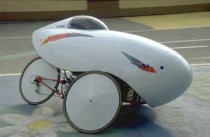
HPV Championship Entrant
For non tilting trikes the rider Center of Gravity (CoG) must be low, and the track (the distance between the contact patches of the two outer wheels) must be wide, certainly much wider than the profile of a standard bicycle and rider. The reason for this is dynamic stability. For a non-tilting trike to be safe, it needs to handle corners at normal speeds without the risk of rolling over. If however you wish to construct a trike with a narrow track and/or high seat, then the only way for it to be dynamiclly stable is to make it tilt.
What causes a non-tilting trike to roll? Well, it turns out that there is an optimal (safe) place where the rider CoG on a trike should be.

Calculating optimal CoG
Looking down from above, if we draw a triangle between the three contact patches and at the mid point of each line we draw another line to the opposite corner, then the intersection of these three lines is the optimal point where the rider CoG should be.

Calculating the lateral tipping point
Now looking from the front, if we take the track measurement B and we divide it in half we get A. We use A to construct an isosceles triangle between the contact patches. This triangle represents the tipping point for the trike. If the CoG is inside the triangle, then the trike will skid when it looses traction while cornering, if the CoG is above it, the trike will tip.

Calculating the longitudinal tipping point
You can also draw a similar triangle on a side view of the trike using the wheelbase measurement for B to derive A. You can then use this side-on triangle to calculate where to place the CoG in order to prevent the trike from tipping forward when breaking -- more of a problem for tadpole configurations.

Calculating the actual tipping point
The previous two calculations would be fine if the CoG on either axis was directly between the two wheels, but its not. The optimum place is 1/3 of the wheelbase length back from the isosceles triangle's base. At this location, the triangle is only 2/3 of the track width.

The optimal CoG tipping space
Now we use this 2/3 track measurement as B to derive A which is 1/3 of the track width. We then use A draw a vertical line up from the optimal CoG point. We then use the point at the top of this line to create a three sided pyramid. This pyramid represents a 3D view of the tipping space, inside which the rider CoG must remain for the trike to be stable.

Optimal CoG simulation
This simulation confirms the theory (download the Juice file here). As you can see, on a non-tilting trike you end up needing an very low seat or a very wide track to keep the rider CoG inside the tipping space.

Paul Sims parallelogram based leaner.

Tilting trikes can corner at higher speeds.
If you want a trike with a higher seat and/or a narrow track, then you have a problem, you simply can't take corners at full clip without tipping. However if the trike tilts you can have a higher seat, because even though the rider CoG may be above the pyramid, as long as the CoG leans to the inside of the outer pyramid plane as it corners, the trike will be stable while cornering. Paul Sims parallelogram based leaner (pictured above) was able to out accelerate and corner other non-tilting trikes competing in a 24 hour OzHpv event.

Banking angle under uniform circular motion
This leads to another factor to consider in all this, the banking angle. It turns out that objects under the force of gravity have a constant banking angle at speed regardless of the objects weight. The formula above is used to calculate this angle. v is the velocity (speed divided by time), r is the corner radius and g is gravity (9.8 m/s2).
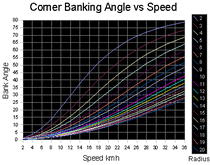
Using the formula, this first graph plots this banking angle as a product of speed. The lines in this case represent the corner radius in meters.

Using the formula, this second graph plots banking angle as a product of corner radius. The lines in this case represent the speed in kph. You can download the Excel spreadsheet here.
On any trike, if you construct the frontal triangle described above using the actual rider CoG (assuming it is above the tipping point) and measure the angle from the outside contact patch to the rider CoG, you can look up this angle in these tables and derive the maximum speed on a particular corner radius the trike can handle without tipping over. Depending on the grip and surface, a tire will generally loose traction at around 45° (1g), so angles beyond this are meaningless.
This of course assumes that the road you are riding on is actually flat. In my area many of the arterial roads are properly engineered, so all these calculations have been used to grade these roads. You can turn a corner on a properly banked road at the posted speed without needing to tilt at all. But they are a double edged sword. When you ride fast down hill a banked corner is helpful, but when you ride slowly up hill, a banked corner is a nuisance. Its one of the many reasons why tilting should always be independent of steering.
Tadpole or Delta?The tadpole trike has the two wheels at the front, the delta trike has the two wheels at the rear. Is one configuration better than the other?

Windcheetah Tadpole
One of the original and best known tadpole trike designs is the Windcheetah by Advanced Vehicle Design. Above is a partially fared example of their Club Sport model. The Windcheetah uses all cast aluminum components that are bonded to a aluminum tubular frame.

Kettweisel Delta
By contrast the Kettweisel by Hase is probably the best known delta trike design. This is a fast, light trike, renowned for its handling.
Assessing Dynamic BehaviorSo from what we learned about the dynamic handing characteristics of trikes on the Why Does Tilting Matter? page -- How do these trikes stack up?
In this section I am not attempting to endorse or recommend one trike manufacturers product over another's, I am simply using these proven designs to illustrate how one might go about assessing the strengths and weaknesses of any trike design. And more to the point, how to assess which characteristics are best suited to your requirements, and on that basis, whether they should be considered for your own designs. This discussion is general and representational. As such it should not be considered definitive. From here on the trike configurations will simply be referred to as 'the delta' and 'the tadpole'.
Braking
Delta rider's CoG
The delta rider's CoG is unusually high for a trike, but it is located behind the forward tipping axis so would be stable under a 1g braking force. Conversly, riding up an unusually steep grade the trike could easily lift the front wheel if enough force was applied to the pedals in a low gear. However as trade-offs go, this is unlikely to ever be a problem in real world riding conditions, so the rearward CoG is a good idea.

Tadpole rider's CoG
The tadpole rider's CoG is lower, but located ahead of the forward tipping axis so it would tip forward under a 1g braking force. With modern caliper brakes, this would have a tendency to lift the rear wheel. On a downward slope the tipping threshold would be even less, exacerbating the problem.
Why not position the front wheels further forward? Well there are some issues with doing this including: the cross member getting in the way of the cyclists calves, and the seat becoming more difficult to stand up out of, because the riders feet are too far forward. Changing the backrest angle to 30° or less will help move the rider CoG further back.
However having the CoG slightly forward changes the weight distribution to favor understeer, which is a good thing. It also means the CoG can be raised slightly, making the seat height more practical.
Turning.
Delta turning vectors
Under turning forces the delta rider's CoG is well placed. Likewise under combined turning and braking forces the CoG is also well places, however as we will see in this implementation the CoG is too high. The long wheel base of the delta also decreases the twitchiness of the steering, improving high speed steering control and precision.

Delta turning simulation
Despite the rearward CoG placement, the delta trike will roll over under simulation (download the Juice file here). Obviously the rider experiencing the inertial feedback and with quicker reflexes could make a course correction better than I can under the simulation. Still, one must lower the CoG to make the simulation more stable.
The rearward weight distribution also favors oversteer, meaning the trike would tend so spin out as a result of loosing traction on loose gravel.

Tadpole turning vectors
Under turning forces the tadpole rider's CoG is well placed, and combined with the low seat, more stable than the delta. However under combined turning and braking forces there is still the possibility of tipping forward.

Tadpole braking simulation
Despite the forward CoG placement, it still takes some effort to get the tadpole to tip forward under simulation (download the Juice file here).

KMX Kart
The KMX trike pictured above resolves the tadpole brake force issue by having smaller front wheels, there by lowering the rider CoG inside the forward tipping axis. Nevertheless, as this image clearly shows, with a more upright backrest angle it is definitely possible tip the trike and get it up on two wheels.
FWDFor a front wheel drive (FWD) delta trike to have adequate traction, more weight needs to be distributed to the front wheel than the rear. Ratios of 60:40 or higher are reccomended.

FWD delta turning vectors
This weight distribution has significant implications for turning stability as this illustration clearly shows. For this reason, I would strongly advise against designing a FWD delta unless it has some capacity to tilt.
ConclusionAlthough Jetrike MkII is a FWD tilting delta trike, I am switching to a tadpole configuration for my next design. The reason for this is that the forward CoG only provides a narrow tilt range with a small margin for error. Additionally when the trike is stationary it can only tilt a little bit before the trike tips over.

The Ideal Tilting Trike
By comparison, the tadpole configuration with a properly centered CoG provides excellent traction, turning and braking stability. It provides a larger tilting range, so you don't have to get the tilt angle exactly right, and it can also be tilted further while stationary without tipping over.
Front or Rear Wheel Drive?One of the many issues to consider when designing a recumbent, is whether to make it front or rear wheel drive (FWD or RWD). The choice is not clear cut. Each approach has its strengths and weeknesses, and like all good design, you have to find the best solution fit for your specific requirements.
| FWD Moving BB | FWD Twist Chain | RWD | |
|---|---|---|---|
| Limitations | steep grades | steep grades | - |
| PSI | manageable | minimal | - |
| Chainline | simple | complex | complex |
| Adjustability | easier | harder | harder |
| Steering Behavior | oversteer | oversteer | understeer |
The above table attempts to compare the relative advantages and disadvantages of each approach, however these are generalizations, and the devil, as always, is in the details.
LimitationsFirst and foremost the significant limitation of FWD designs is their potential to loose traction on steep grades (hills).

Minimum 60:40 weight distribution
On level ground, the FWD recumbent should have more weight distributed to the front wheel than the rear. Ratios of 60:40 or higher are reccomended.

Loss of traction of steep grades
The problem is that as the grade becomes steeper, the weight distribution changes to favor the rear wheel. The illustration above is extreme, and most riders even on hilly terrain don't consider FWD traction a significant issue. If however you are planning to ride off road, the friction coefficient of gravel, mud and dry grass is much less than tarmac, so traction will become a limiting factor. You can reduce the impact of grade on weight distribution by keeping the seat height low and increasing the wheelbase.
Pedal Induced Steering
Effect of Trail on FWD
One significant issue for FWD designs is the effect of trail on dynamic stability and pedal induced steering (PSI). To illustrate this, the diagram above represents the view looking down on a 20" front wheel that is moving forward down the page. It has a 75° pivot angle, 20mm of fork offset and is leaning 30° to the left. As the front wheel leans, the contact patch moves to the inside of the pivot axis. This is because the contact patch is moving around the outside wall of the tire. This causes the driving force (Red) to generate a turning force (Blue) around the pivot axis, but because the application of human power using pedals is not constant, the turning force oscillates. These oscillations will generate sympathetic harmonics at certain cadence frequencies due to the shifting weight of the legs while peddling, and their interaction with the dynamic tracking behavior of caster.
On FWD twist chain designs, having a shallow pivot axis, short trail and long tiller minimizes the impact. On FWD moving BB designs however, the turning force will interact with the pedal force, alternating between cooperation and opposition. At some cadence frequencies this actually eliminates PSI effects and works well, at others, particularly high cadence it causes stability problems.
ChainlineIn my experience chainline management is the single biggest issue in recumbent design. You can come up with a beautiful bike or trike, but if you can't transfer power efficiently form you feet to the drive wheel(s), then you will have to revise your design.

FWD moving BB chainline
The FWD moving BB design is used by the TT, Cruzbike, Speculoos, Python lowracer and Flevobike, as well as the Hipperion trike. When properly designed, pedal induced steering can be kept to a minimum. This is a challenging configuration, but in the case of the Python lowracer, it can produce a very light bike. The direct, unencumbered chainline is also the most efficient, the chain routing used in the other designs has been reported to consume over 5 watts.

FWD twist chain chainline
The FWD twist chain design has become extremely popular of late, particularly in the HPV racing scene. This design is favored by fully fared streamliners used in HPV speed trials because it helps to keep the frontal profile of the faring to a minimum.
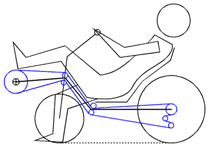
RWD chainline
RWD is by far the oldest and most widely used chainline design. It is constrained by the seat height -- make the seat high and you can have an unencumbered chainline like the Cycloratio -- make the seat low and you have to route the chain over the front wheel and under the seat. For a tadpole trike this is less of an issue than for a bike, in that you only have to route the chain under the seat, but the front cross member and steering tie rods can also get in the way.
Adjustability
FWD moving BB adjustablity
One of the challenges all recumbent designs face, is making the distance from the seat the bottom bracket (BB-BOS) adjustable. It is often undesirable to make this adjustment by moving the seat backwards and forwards, because this may upset the ride quality and handling characteristics. Most designs incorporate some variant of a telescopic boom. However with most chainlines, this requires adding or removing chain links to make the adjustment, on the theory that once fitted to the rider, the BB-BOS distance never needs to change. If however you are planning to race in a 24 hour HPV event with a team of riders, quick changeovers are a requirement. The FWD moving BB design is rather unique in this regard, the bottom bracket can be design for adjustment without any need to modify the chain. The alternative for routed chain lines is to have a longer chain and use an adjustable chain tensioner on the return run.
Steering BehaviorThe angle between the direction a wheel is pointing and the path along which it actually moves is called the slip angle. Slip occurs under power when a trike is turning. It also occurs under breaking as the tire approaches its traction limit. Under power the weight distribution usually moves to the rear of a vehicle, but human power being as limited as it is, acceleration forces are rarely an issue, unless you ride a unicycle. Under breaking the weight distribution moves to the front outside wheel.
How the steering behaves under power is dependent on the weight distribution and the friction coefficient of the tire and road surface. Steering behavior becomes more pronounced when the friction coefficient is low i.e. a verge with loose gravel while cornering. Too much weight at the rear causes the rear to spin out (oversteer). Too much weight at the front causes the front wheels to plough (understeer). Neutral handling is when the weight is evenly distributed between the front and rear, but generally slight understeer is considered safest.

RWD understeer behavior
RWD trikes have a tendency to understeer. This is because the drive force is pushing the trike forward in a straight line, and the front wheels slip forward as they turn. It is only the friction of the front wheels on the pavement, not the driving force that turns the trike. The location of the optimal CoG also creates a weight distribution that favors understeer.
Under the decelerating forces of braking the steering behavior may be completely different. It is dependent on the dynamic weight distribution, which is directly influenced by the location of the rider CoG in relation to the front contact patches, the seat height, the brake force distribution, and the amount of brake force applied.

FWD oversteer behavior
FWD trikes have a tendency to oversteer. The drivetrain pulls the front of the trike around the corner. It is only the friction of the rear wheels on the pavement that prevents the rear of the trike from spinning out. However because the weight distribution is already biased towards the front wheel to improve traction, these forces tend to cancel one another out. In competitive racing, particularly on short tracks with lots of cornering, riders may prefur the responsive feel of slight oversteer, but it carries the added risk that the rider may loose control. Too much oversteer will make a trike unstable and dangerous.
I have confirmed this behavior with Jetrike. When turning sharply enough on gravel so all three wheels drift, the trike is generally well balanced, if however traction is completely lost, oversteer combined and an abrupt loss of momentum is the frequent result, but being a trike, easy to recover from.

Soloviov S-4 all wheel drive trike
The S-4 trike pictured above, features all wheel drive (3 x 3), which would actually come in handy on icy winter roads. It all comes down to what your requirements are. For most trikes the critical safety issue is how well it handles under extreme breaking and cornering conditions, and that is all about the location of the rider CoG and weight distribution.
Front or Rear Wheel Steer?As a first time builder, you will no doubt be considering all possible permutations for your trikes design. This will inevitably lead to questions about rear wheel steer (RWS) -- Does it work?
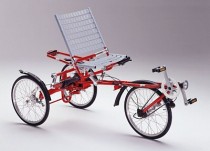
The Culty FWD RWS delta trike
The attraction most certainly is the simple, fixed drivetrain and direct chainline that a RWS delta trike affords.

RWS exhibits classic oversteer behavior
However a quick Google search will probably put the idea to rest, most authorities on the subject have concluded long ago that RWS creates oversteer, and oversteer is unstable and dangerous at speeds above about 10kph. As the illustration above clearly shows, the path along which a RWS trike travels has all the hallmarks of oversteer. Another problem illuminated by the diagram above, is that the rear of the trike moves towards any obstacle you may be trying to avoid -- not so good if that is another vehicle or pedestrian.

The Sidewinder FWD RWS tadpole trike
Nevertheless, many designers have attempted RWS with varying degrees of success. Take for example the Sidewinder shown above, which is a commercial RWS, FWD tadpole trike. The obvious question -- Given what I have just been told, how can this be safe?

RWS FWD simulation
The image above shows the simple simulation I created to verify the Sidewinder design (download the Juice file here). For a RWS trike, it has surprisingly good handling.

Countering the oversteer
This has been accomplished by moving the rider CoG forward, which counters the RWS oversteer with weight distribution that favors understeer, making the trike fairy evenly balanced. However this also moves the rider CoG in front of the forward tipping axis, which compromises deceleration performance under braking forces. Despite this limitation, it is a cleverly resolved RWS design with stable cornering characteristics.

The SoonW T3 RWS FWD delta trike
As the above photo illustrates, the biggest drawback of a RWS delta is that the rear of the trike moves toward the thing you are trying to steer away from. This is not so great if the thing happens to be a parked car or a pedestrian. Nevertheless, one day I would really love to have a crack at RWS. Owners describe the shear pleasure of riding a trike that turns like a speed boat, your body sinking into the seat as you turn.
Early Experiments
Inspiration
Much of my initital inspiration for Jetrike came from seeing Bram Smit's <www.fastfwd.nl> tilting trike.
 | 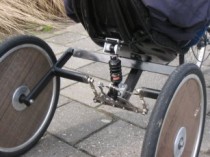 |
Bram Smit credits his inspiration as comming from a Spanish builder, Carlos Calleja <www.moebius.es/ccalleja/> and his three wheeled motorcycle prototype. Carlos was granted US patent 5611555 for his invention in 1997.
 |  |  |
Key Influences
Some other designs that influenced Jetrike include...
 |  |
| The Hipparion is a front wheel drive (FWD) lean-steer trike built by Esko Meriluoto <personal.eunet.fi/pp/davinci/osa5eng.html>. This trike has negative trail and a steering dampener to prevent dynamic instability (shimmy) at high speeds. | The Python is a two wheeled center steer bike invented by Jürgen Mages (pictured above) <www.python-lowracer.de>. Despite having negative trail, the Python geometry provides dynamic stability by generating a self-centering effect. I believe that free to castor (FTC) is actually at work here. |
 | 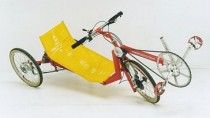 |
| The Speculoos is a FWD two wheeled recumbent bike developed by Laurent Dechenne <les-velos-de-laurent.skynetblogs.be>. It features positive trail, but according to Laurent, to reduce pedal induced steering the bottom bracket height must be level to the seat height and the pivot angle should be between 55° and 60°. | This parallelogram based FWD tilting trike was developed by Paul Sims <www.greenspeed.com.au/australia/paul> (son of legendary trike builder Ian Sims of Greenspeed). He built it to compete in a 24 hour HPV challenge. The parallelogram based tilt geometry required a caliper brake to manually lock the tilt mechanism when stationary. |
Patent US4887829 (full) | |
|---|---|
 | This is the earliest reference I have found to the type of tilting mechanism used in the Jetrike design. This patent was filed by its inventor Curtis L. Prince in 1987. Seeing we are now in 2007 this patent has actually expired, so we are all free to use his invention in future designs. You will notice that the tie rods between the swing arms and rocker arms have shock absorbers. |
Patent US5611555 | |
 |  This is the patent filed in 1994 by the Spanish builder Carlos Calleja for his three wheeled motorcycle design. His patent claims cover the motion de-activated tilt lock and suspension mechanisms. This is the patent filed in 1994 by the Spanish builder Carlos Calleja for his three wheeled motorcycle design. His patent claims cover the motion de-activated tilt lock and suspension mechanisms. |
Patent US3964563 (full) | |
 | Ross Cowie on the Yahoo tilting group <groups.yahoo.com/group/tilting> brought this patent to my attention. Filed by Carling D. Allen in 1975, it covers a swing arm design not unlike the Prince design, only using other means including one with pulleys (left) and others using gears to generate the counter action in the opposing swing arm. |
Patent US3981516 | |
|---|---|
 | This patent was filed by a Swedish builder, Björn Häggkvist in 1975. It is an interesting FWD design where the seat and drive train form one frame, and the delta rear end another. The steering pivot itself is driven by a sprocket on the handle bar stem. This approach eliminates pedal induced steering, but the problem with this design, like many other lean steer trikes is that the rider center of gravity (CoG) appears to move outward as the trike turns. |
Patent US4432561 (full) | |
 |  |
| This patent was filed by Roger H. Feikema and Harry J. Bakker in 1982. Trailmate <www.trailmate.com> manufacturers these under the name 'Fun Cycle' and 'Banana Peel' and they are marketed as an industrial bike for the tourist bike rental market. A British company Trixstar <www.trixstar.co.uk> also made an identical looking trike (pictured above). | |
Patent US4526392 (full) | |
 |  |
| The Vacuum Velocipede was invented by Dave E. Berkstresser, who filed his patent in 1982. This trike was way ahead of its time, and although it never set any speed records, it certainly is a unique speed machine. With a very low steering pivot angle it reportedly suffered from serious wheel flop, in an attempt to fix this, a linear drive was added to lower the CoG of the riders legs. | |
Patent US5568935 (full) | |
 |  |
| This patent was filed by William P. Mason in 1995 and the trike went into production under the name 'Tricumbent Raven'. From what I understand, Tricumbent have ceased trading and the IP is now owned by Just Two Bikes <www.justtwobikes.com> who sell a very similar trike called the 'Tricumbent'. While the rear wheel steer delta trike is considered by most to be unstable, a prolific home builder, Timothy Smith <www.ihpva.org/people/tstrike/home.htm> who has built one, is quoted on his web sit as saying: "if I had only 1 machine it would be this". | |
Patent US5762351 (full) | |
 |  |
| This is Wayne Soohoo's <www.maxmatic.com/soohoo.htm> very cool Aileron tilting trike. His trike has a special ratcheting spring clutch in the handle bar stem that controls the tilt lock. As I understand it, tipping the handle bar to the side, activates the clutch, and a spring pushes the tilting bike back to center. It is a very interesting concept, and from the perspective of stability, his tilting tadpole trike should have better stability than a delta, because the CoG is more central to the intersection of the contact patches. I only wish he had had more commercial success with it. His patent was filed in 1995. | |
Patent US6062581 | |
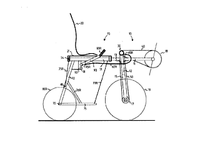 | 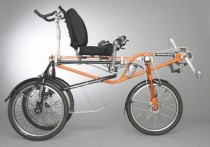 |
| This is patent was filed by William J. Stites of Stites Design <www.stitesdesign.com> in 1996 for his Chameleon leaning three wheeled HPV. For such an interesting and beautifully realized design, the drawings in the patent application are rather ordinary. | |
Patent US6402174 (full) | |
 |  |
| Alan Maurer invented this leaning trike that features steering modulation control. This is an inspired design. You control the lean by pushing side to side on the handle bars. At the same time you control how much the lean influences steering by pitching the handle bars forward and back. The only potential problem with this design is that the breaking torque on the front wheels is transferred to these steering controls. Alan entered the trike in 2002 HPV Championship <www.ihpva.org/Races/ihpsc28_res.html> held at Brantford, Ontario, Canada. Here are some detailed photos of the front and rear. His patent was filed in 2001. | |
Design Patent USD450631 | |
 |  |
| This is a design patent filed in 2001 by Robert Ridley and Eric Jackson of APAX Vehicle Developments Inc <www.apax.ca>. These are some crazy trike builders -- they have a video where they literally ride it down a set of stairs (above). But I wonder just how much that air suspension actually weighs. On this bike, when you stop, you still have to press a button to lock the tilt mechanism. | |

